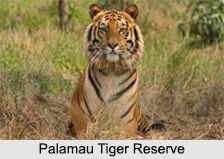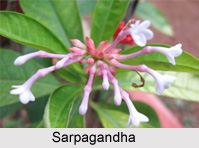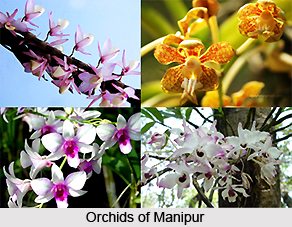 Out of the nine original tiger reserves of India, the Palamau Tiger Reserve is one holding a treasure of wild flora and fauna segregated throughout the sanctuary. The Palamau Tiger Reserve is the only tiger reserve in Jharkhand, India. It forms a significant part of the Palamu Wildlife Sanctuary and the Betla National Park. It covers an area of about 1026 sq kilometers on the Chota Nagpur Plateau. The main attractions of this reserve are its tigers and elephants. It is also home to more than 100 species of birds. The picturesque and hilly landscapes make a beautiful spot for excursions tours.
Out of the nine original tiger reserves of India, the Palamau Tiger Reserve is one holding a treasure of wild flora and fauna segregated throughout the sanctuary. The Palamau Tiger Reserve is the only tiger reserve in Jharkhand, India. It forms a significant part of the Palamu Wildlife Sanctuary and the Betla National Park. It covers an area of about 1026 sq kilometers on the Chota Nagpur Plateau. The main attractions of this reserve are its tigers and elephants. It is also home to more than 100 species of birds. The picturesque and hilly landscapes make a beautiful spot for excursions tours.
History of Palamau Tiger Reserve
The story of the formation of the Palamau Tiger Reserve has a long history behind it. It was once the seat of the Gond Chero rajas that were accountable for the magnificent 16th century forts on the banks of the Koel and the Auranga. For them, thick, virgin forest shaped an almost invincible shelter from Daud Khan`s occupying army in the year 1660. Much later in the 19th and early 20th centuries, these forests were considered to be ideal hunting grounds for the regal families.
Climate of Palamau Tiger Reserve
The climatic conditions of Palamau are persistent during summers as they are really dry and hot. The maximum temperature can reach up to 48 degrees Celsius. However, the climate turns pleasant with the arrival of winter. The temperature can become too cold reaching a down level of 3 degrees Celsius.
Typography of Palamau Tiger Reserve
The typography of the Palamau Tiger Reserve is a mix of lakes, rivers, and valleys. The winding North Koel River and its river branch, the Auranga, slash through the rocky lands of the northern part of Palamau. The Kanhar and Amanat rivers run through the Betla region of the tiger reserve area, which lies amid lush tracts of sal and other dry deciduous trees. Palamau Tiger Reserve becomes dry and parched during the sultry days of the summer season. However, the forest area again gets back their original lushness in months of rain with the rivers overflowing the area. Low lying waterfalls all of a sudden make appearance, thus contributing the whole of Palamau Tiger Reserve to become an amusing place for vacation, especially during the rainy season.
Wildlife of Palamau Tiger Reserve
Palamau Tiger Reserve is an abode of a large number of mammals and various other wild habitats. Based on `pugmark count` the first-ever tiger census was being recorded in Palamau in the year 1934. Wild elephants can be seen here, often being seen cooling down for biting the heat in the waters of the Betla dams. Their numbers are quite small and it is thought that they were brought in to this region. The Maharaja of Surguja has brought about twenty elephants to increase the populace here, and also the large animals likely transmigrated from nearby forests in the early 1900s.
Quite a number a mammalian species are found within the premises of Palamau Tiger Reserve. These are namely Asian Elephant, Leopard, Wild Dog (Dhole), Jungle Cat, Wolf, Small Indian Civet, Jackal, Striped Hyena, and Sloth Bear. Also, few Indian Bison, better known as Gaur and also Sambar, Spotted Deer (Chital), Barking Deer, Indian Pangolin, Common Langur reside at ease mainly in the dense forests of the region.
No wonder, everyone who visits the Palamau Tiger Reserve gets enchanted by the sights of beautiful birds. Various woodland birds include Red Jungle fowl, Black Francolin, Oriental Pied Hornbill, Greater Flameback, Green-billed Malkoha, Grey-bellied Cuckoo, Greater Racket-tailed Drongo, Indian Pitta, Black-hooded Oriole, Jungle Myna, Asian Paradise-flycatcher and White-rumped Shama etc.
 By the sides of the rivers and water bodies, one can get a glimpse of birds like Lesser Adjutant, Black Stork, Woolly-necked Stork, Painted Stork, Grey Heron, Black Ibis, Stork-billed Kingfisher.
By the sides of the rivers and water bodies, one can get a glimpse of birds like Lesser Adjutant, Black Stork, Woolly-necked Stork, Painted Stork, Grey Heron, Black Ibis, Stork-billed Kingfisher.
Carnivorous birds too are no less important. They had a peaceful co-existence with the other bird species. Crested Serpent Eagle, Lesser Spotted Eagle, Steppe Eagle, Grey-headed Fish Eagle, White-eyed Buzzard, Common Kestrel, Eurasian Eagle Owl are examples of some bird raptors of Palamau Tiger Reserve.
Among the first nine reserves of Project Tiger that was started in the year 1973, Palamau Tiger Reserve deserves special mentioning. Whether it will endure its exuberance in the future also largely depends on the mammoth initiatives that are needed to ensure its long-lasting sustained conservational initiatives.
Tourism at Palamau Tiger Reserve
Tourists throng the Palamau Tiger Reserve in a large number. The best time for visiting the place is during the hot, dry, summer months when the wild animals are seen near the water bodies. The Hathibajwa watchtower and the observation hide at Madhuchuan in the Betla area are full of ponds that throng with wildlife. The authorities, in order to improve the water situation here have initiated several steps. Apart from protecting the wild habitat, they are also taking lots of pain in making man-made water holes. There are also facilities of excursion both inside the reserve and as well as at nearby places. Deoghar is one of the most spiritual and sacred places in the Santhal Parganas of Jharkhand. It is also a dham or pilgrimage center known as Baidyanath Dham. Its main attraction is the temple of Shiva Baidyanath. Netarhat, also popularly recognized as The Queen of Chotanagpur Plateau is covered with thick forests at a height of about 3700 feet. It is a famous site for sunrise and sunsets. The Safaris are a daily drive where Open 4WD vehicles are available for visiting the whole Palamau area. Other activities include birds watching and visiting nearby national parks.
Visiting information of Palamau Tiger Reserve
The areas do not have any train station available. The only nearest railway station is Dhanbad at 245 km distance from Palamau. The tiger reserve is located in the Palamau district which is 25km away from the headquarter city of Daltonganj which offers trains to every important city of India. Ranchi, the capital city of Jharkhand has the nearest airport. The reserve is also connected extensively with Belta at a distance of 26km. the best time to visit is from January to June.











